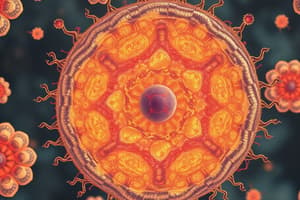Podcast
Questions and Answers
What key characteristic differentiates prokaryotic cells from eukaryotic cells?
What key characteristic differentiates prokaryotic cells from eukaryotic cells?
Prokaryotic cells lack a nucleus.
Identify one function of mitochondria in eukaryotic cells.
Identify one function of mitochondria in eukaryotic cells.
Mitochondria are responsible for respiration and energy transfer.
Explain the role of ribosomes in the cell.
Explain the role of ribosomes in the cell.
Ribosomes are involved in protein synthesis by translating genetic material.
What additional structures do plant cells have that are not found in animal cells?
What additional structures do plant cells have that are not found in animal cells?
Describe the function of the cell membrane.
Describe the function of the cell membrane.
What are plasmids and their significance in bacterial cells?
What are plasmids and their significance in bacterial cells?
List one main component of the plant cell wall and its role.
List one main component of the plant cell wall and its role.
How do bacterial cells replicate their genetic material?
How do bacterial cells replicate their genetic material?
What is the function of chloroplasts in plant cells?
What is the function of chloroplasts in plant cells?
Describe the significance of the large vacuole in plant cells.
Describe the significance of the large vacuole in plant cells.
Flashcards
Eukaryotic cell
Eukaryotic cell
A type of cell that has a nucleus and other membrane-bound organelles, like mitochondria and chloroplasts. Animal and plant cells are examples.
Prokaryotic cell
Prokaryotic cell
A simpler cell type, lacking a nucleus and other membrane-bound organelles. Bacteria are examples.
Nucleus (in eukaryotes)
Nucleus (in eukaryotes)
The control center of the cell, containing the genetic material (DNA) arranged in chromosomes.
Cytoplasm
Cytoplasm
The jelly-like substance filling the cell outside the nucleus, where many chemical reactions happen.
Signup and view all the flashcards
Cell membrane
Cell membrane
The outer boundary of the cell, controlling what enters and exits the cell.
Signup and view all the flashcards
Mitochondria
Mitochondria
The powerhouse of the cell, where energy is produced through respiration.
Signup and view all the flashcards
Ribosomes
Ribosomes
The cell's protein factories, responsible for making proteins.
Signup and view all the flashcards
Cell wall (plants)
Cell wall (plants)
A rigid outer layer made of cellulose that supports and strengthens plant cells.
Signup and view all the flashcards
Large vacuole (plants)
Large vacuole (plants)
A fluid-filled sac in plant cells that maintains internal pressure and stores substances.
Signup and view all the flashcards
Chloroplast (plants)
Chloroplast (plants)
The site of photosynthesis in plant cells, where food is made using sunlight.
Signup and view all the flashcards



